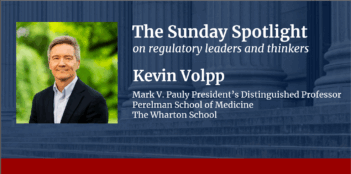
Popularizer of nudges offers a short introduction to their use by government.
As evidenced by the Behavioral Insights Team launched by the UK government as well as the creation of a White House Social and Behavioral Sciences Team, so-called nudges have caught fire with policymakers around the globe. Popularized by Richard Thaler and Cass Sunstein’s recent best-selling book, the nudge idea has been praised as a low-cost, choice-preserving innovation – while criticized as too paternalistic and full of unintended consequences in practice.
But what exactly is “nudging”? And how does its approach differ from traditional forms of regulation? In a recent paper, Cass Sunstein offers a brief guide to nudges, along with a list of what he deems the ten most important nudges for purposes of policy creation. Arguing that transparency, evidence, and testing are integral to nudges’ success, Sunstein proposes two models for institutionalizing nudges in a way that ensures appropriate levels of specialization, robust research design, and capacity to drive real reform.
Sunstein defines nudges as “liberty-preserving approaches that steer people in particular directions, but also allow them to go their own way.” Nudges—also known as “behaviorally-informed regulation”—originate from the notion that human beings are boundedly rational and often rely on heuristics, biases, rules of thumb, and other reasoning shortcuts, usually resulting in suboptimal decision-making.
Policymakers who design nudges are “choice architects,” in Sunstein’s terms, because they are responsible for creating the social environment or choice architecture that drives people’s decisions. Thus, any element of the choice architecture that influences people’s behavior in a specific way without prohibiting alternatives or changing incentives is a nudge, says Sunstein. Putting healthy meal options at children’s eye-level in a school cafeteria is a nudge. However, banning soda (a mandate) and taxing sugary drinks (an economic incentive) are not nudges.
Although nudges are often referred to as a form of “soft paternalism,” Sunstein argues that they protect freedom of choice even as they prod people in a particular direction. A graphic warning label on a pack of cigarettes that features a throat cancer patient is designed to repel smokers, but the decision whether to buy the pack is still in the hands of the individual consumer. Similarly, a GPS steers drivers towards a faster, simpler route, yet they are always free to choose their own path.
In order for nudges to be successful, Sunstein says, the need for transparency, evidence, and empirical testing is paramount. Whether a government decides to put in place default rules for public assistance programs or whether a private employer adopts a program that automatically enrolls workers in a pension program, the action should be transparent and open, never taking the form of manipulation or trickery, Sunstein says. Moreover, as with traditional regulation, public review and appropriate institutional checks form an integral part of an effective government nudge strategy, he argues.
Responding to critics who say that nudges that seem promising in theory might malfunction in the real world, Sunstein advises that nudges should be empirically tested. In fact, Sunstein emphasizes that experimentation in a way that enables continuous measurement and improvement is a foundational part of nudges. To test nudges’ effectiveness, Sunstein specifically suggests the use of randomized controlled trials, which minimize the risk of bias in clinical interventions via random allocation of participants to experimental and control groups.
Sunstein subsequently catalogs some of the nudges he considers most important for public policy. Default rules—which generally entail automatic enrollment in programs—are best used when a decision not to choose can have a large, detrimental impact, Sunstein explains. Thus, automatic enrollment in retirement plans can significantly increase employees’ savings while direct certification in free school meals can alleviate child hunger and improve well-being.
Another very effective nudge, he writes, is the use of social norms to inform people that their counterparts are engaged in some type of behavior. For example, notifying people that the vast majority of their neighbors pay their taxes on time can drive up the rate of timely tax returns.
Another type of nudge—disclosure policies—Sunstein says, can be very successful if the divulged information is comprehensive and easily accessible to the targeted audience. The Credit Card Accountability Responsibility and Disclosure Act of 2009, which requires creditors to maintain a website on which they post copies of their cardholder agreements, is an example of disclosure. Moreover, the Open Government Partnership—a growing international network of reformers from 65 countries seeking to increase transparency and accountability in government—showcases just how popular disclosure has become, says Sunstein.
Sunstein concludes with a discussion of two mechanisms for institutionalizing public policy consideration of nudges. On the one hand, governments could rely on already existing, fully functional institutions to incorporate nudges into policymaking. The success of this approach, however, requires government officials already possessing the requisite knowledge and to achieve reforms, cautions Sunstein.
A different approach would entail the creation of a wholly new, independent institution akin to the UK’s Behavioral Insights Team – or so-called Nudge Unit. The strength of this model draws from a specialized team of experts specifically dedicated to the work of nudging; however, its weakness also stems from its separateness. It might function as a kind of outsider, with little ability to initiate real reform. Sunstein emphasizes that the UK’s Nudge Unit has been successful precisely because it has enjoyed high-level support and access from Cabinet members and departments.
Sunstein justifies the growing popularity of nudges around the world based on their effectiveness, efficiency, and ability to preserve citizens’ freedom to choose. Of course, as with all policies, some nudges may fail while others may prove glowingly successful. The key, Sunstein says, is a dedicated team with a commitment to experimentation and to learning what works and what does not.



